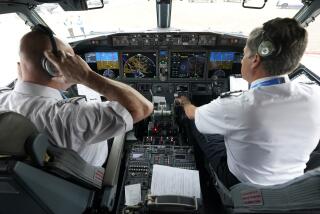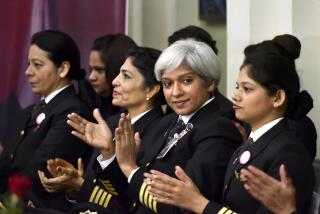Veteran Pilots Eagerly Return to Skies : Pan Am Recalling 600 Furloughed Fliers, Some After 16 Years
- Share via
WASHINGTON — Phil Vampatella recalls Christmas of 10 years ago as the worst one of his life.
The commercial pilot and father of four children, at the age of 36, found himself with a Georgian-style house in Maine, a hefty mortgage and a notice from his employer, Pan American World Airways, that he was being furloughed.
This year, Pan Am recalled Vampatella. After a decade of working at jobs that ranged from selling insurance to Mack trucks, the Navy combat veteran eagerly returned to the cockpit.
“I thought about it for about a hundredth of a second,” he says. “It never occurred to me to do anything else.”
Thousands Laid Off
Being furloughed is no novelty to Americans in many walks of life, including the airlines. In recent years, fluctuations in economic conditions have put tens of thousands of Americans on the streets in search of alternative means of support.
Most furloughs end after a few months or a few years, however, and if they don’t, most of those who are laid off mark an end to one stage of life and begin a new one. They look back more in reminiscence than in hope.
The case of Vampatella and his colleagues at Pan Am is an exception.
Some Waited 16 Years
Although some of the Pan Am pilots had been on the airline’s furlough list for as long as 16 years--and had moved to new cities, earned new college degrees, started businesses or become entrenched in new jobs--most of the Pan Am pilots now are coming back.
As part of the boom in the airline industry in recent years, Pan Am this year has been recalling all of the 600 pilots that it released, most in the early- to mid-1970s. A full two-thirds of them so far have chosen to return, and others are considering joining them.
For most, the chance to resume building their seniority and pensions and to work again with longtime friends in the air overcame the nuisance of the required retraining, job status lost to some younger pilots and the prospect of another major life change.
“It’s a unique thing, flying an airplane and being a professional pilot,” said pilot Marc Bornn of South Kent, Conn.
“Anybody who goes back will tell you it’s their first love,” said Van Nelson, 46, of San Jose. “It always was with me, and it still is.”
Happy Reunion Scene
The pilots’ return has created a scene much like a high school reunion at Pan Am. They are trading pictures of children and grandchildren and recounting the torments suffered and new beginnings made in the years they were apart.
“It’s a very sweet, personal joy to see these people back,” said Errol Jonstad, a Pan Am captain whose seniority saved him from furlough. The first major round of Pan Am pilot layoffs began in the 1970s, when the airline started to phase out its uneconomical fleet of more than 100 707-model aircraft and replace them with 747 jumbo jets. Some pilots returned within a year, but were laid off again in a company retrenchment.
Their chances of being recalled dimmed when Pan Am merged in 1980 with National Airlines and had to integrate National’s seniority list with its roster.
Many Pan Am pilots hoped the furloughs would be temporary, but the weeks stretched into months and then years.
Nevertheless, it was a job they loved, and many refused to give up hope. More than a few of them suffered from bouts with depression. There were divorces and drinking problems.
Clung to Seniority
A number of them joined other flying operations as airline deregulation in the late 1970s increased the demand for pilots, but many were reluctant to sign up with other large carriers and abandon their seniority with Pan Am. Others entered new businesses--ranging from real estate to pizza. Some became millionaires.
One cleaned swimming pools; another cleaned corn-husking machines. Many of them bounced between jobs.
“It was a very, very traumatic situation,” said Bill Madden, 50, of Tampa, Fla., who was furloughed in March, 1976, and rejoined Pan Am this year.
Madden and his wife, Karin, started selling physical-therapy equipment in Florida, although he expected at any moment to return to Pan Am. “In 1979,” he said, “I realized that I really had to get jumping and get the business to a point we could live off it.”
Today, the business is doing very well and he is staying with it, but he could not completely reject the idea of returning to the skies. He accepted reserve status with Pan Am, to fly on call.
Started Air Charter Firm
One of the most successful furlough refugees was Bornn. He flew corporate jets for a year before he went into the now-lucrative business of helping companies, rock stars and celebrities charter private aircraft.
Calls From Buddies
Bornn considered turning down the Pan Am recall, but after several calls from his buddies who were back in training, he rejoined and is flying 727s out of New York as a first officer.
“For me, it was not the money,” he said of his decision. He had missed the contact with people and the enjoyment of flying.
His wife, Janette, said her instinct told her that he would return to Pan Am: “He was born to fly,” she said.
Christopher Thomas Hayes III of Dallas took a different route when he was laid off in 1976.
“I sort of staggered around for two years, trying to decide what to do,” he said. Then he finished work toward a college degree, went to seminary school and was ordained in the Episcopal Church in 1983.
Today, with the support of church officials, he is both priest and pilot. He has a “wonderful” little mission church in Wylie, Tex., about 30 miles from Dallas. He flies 16 to 20 days a month for Pan Am and tries to arrange his flight schedule around Sunday services.
‘Something Magical’
While the retirement benefits were a big factor, “There is something magical about flying that will never lose that glow,” the former fighter pilot said. “It has been so much a part of my life that it’s difficult to close the door.”
Some had fewer happy experiences during the furlough period, and more pressing financial reasons for returning.
After he was laid off in 1970, Nelson spent two years working on his father’s ranch in Idaho, waiting and hoping to be recalled. He then got a job as an air traffic controller, only to lose it when President Reagan fired 11,400 striking controllers in 1981.
Unemployed again, he took a job as a pipe fitter. “I decided I would have a job nobody could fire me from,” he said. Although he is going back to Pan Am, he vows never to be completely vulnerable again. “I know I can always go back and work with my hands,” he said.
Vampatella said that when they drive by the house they lost in New Gloucester, Me., “My wife still cries.” To help rebuild his self-confidence during the furlough years, he headed a project to build a Vietnam War memorial in Maine.
Refresher Training Given
After attrition and the wide demand for pilots opened up jobs at Pan Am this year, the recalled fliers reported to the airline’s flight academy in Miami for six to eight weeks of refresher training. Even those who had not flown much in the interim years insist that they never lost their flying skills, but they say they now need to learn about specific systems on different aircraft.
“The dedication of these individuals coming back is just amazing,” said another returning pilot, Robert Peterson, 45, of Miami.
Kurt Axelsson, 47, of Cape May, N.J., recently gave a reunion dinner for some of his fellow returnees. He said: “We have a bit of gray hair and a few pot bellies, but we’re pretty much the same. It’s nice to be with somebody who thinks like you do after so many years.”
And they are all waiting to see Robert Finley, a name well known among them as the last on the furlough list. Finley, 47, of Richardson, Tex., was laid off on Dec. 30, 1969, and is due to get his recall notice by the end of the year.
As to whether he will be reporting back, Finley, now a successful businessman who deals in plastics and paper, said: “I’m still flexible.”
More to Read
Inside the business of entertainment
The Wide Shot brings you news, analysis and insights on everything from streaming wars to production — and what it all means for the future.
You may occasionally receive promotional content from the Los Angeles Times.










